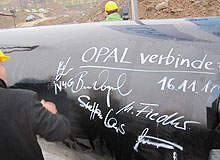
Net4gas, an independent natural gas transporter, began construction of the 169km Gazelle gas pipeline in the Czech Republic in October 2010. The 56in-diameter pipeline will have a transmission capacity of 30-33bcm per year and will import gas from Russia.
The pipeline is being built through an investment of €400m and will be completed by the end of 2011. RWE, a subsidiary of Net4gas, will execute the project.
The Czech Republic is one of many EU countries that depend on imports to meet nearly half of their fuel demands. By 2050, this figure is expected to increase to 80%. The new pipeline is an effort by the EU to ensure safety and reliability of energy supplies to the region in the future.
The new pipeline will improve security of supplies in the Czech Republic and increase competition in the country’s gas market. It will also enable direct gas supplies to the country by connecting it to eastern Europe. This will be achieved either through new or alternative routes such as the Nabucco pipeline.
The new pipeline will be of strategic importance for Czech Republic and the neighbouring countries in the event of an interruption of gas supplies from Ukraine.
In September 2011, the European Commission announced that the pipeline will be exempt from European revenue and third-party access (TPA) regulations for 23 years.
Gazelle pipeline route
The Gazelle pipeline will follow the path of existing pipelines. It will start from Brandov in Hora Sv Kateřiny on the Czech Republic’s north-western border of Germany.
“ILF Consulting Engineers is the design engineer for the Gazelle pipeline.”
The pipeline will end at the Rozvadov / Waidhaus transfer station on the Czech-German border in the west.
The pipeline will then be connected to the MEGAL transit system, which will transport gas to southern Germany and then on to France. A 300m-long section from Olbernhau in Germany to Brandov will also be built as part of the project.
Construction and infrastructure
The Czech Republic Government approved construction of the project in September 2008. Construction of the transfer station at Rozvadov / Waidhaus began in October 2010. The Gazelle pipeline was connected to the Opal pipeline in November 2010.
The pipeline will be laid with a 36m-wide minimal land annexation. Pipeline sections to be laid under railways, motorway, and class I, II and III roads will be built using the ‘push’ technique, which ensures minimal damage to the surface.
The pipeline will be laid about 0.8m underground. The soil stripped during construction will be restored to its original condition after laying the pipeline to avoid mixing of different underlying layers.
Technology
An optical cable will be laid along with the pipeline to monitor its operation. Pipeline inspection gauges (PIG) will be installed to examine the condition of the pipeline.
The PIG, driven by the pressure of gas, moves through the pipeline and helps in inspecting the condition of the pipeline without the need for excavation.
“The Gazelle pipeline will follow the path of existing pipelines.”
Connection
The Gazelle pipeline will carry natural gas from Russia to Czech Republic through interconnections with the Opal and Nord Stream pipelines. The Nord Stream pipeline will carry gas from Russia to Greifswald in Germany. The Opal pipeline will be connected to the Gazelle pipeline here, for carrying gas further to Brandov.
The pipeline will be linked to the Czech Republic’s existing gas system through various interconnections planned at Brandov, Jirkov, Sviňomazy and Přimda.
Gazelle pipeline contractors
Stroytransgaz was awarded a €62.6m contract to build a 52.3km section of the pipeline between the towns of Hora Sv Kateřiny and Rozvadov. The company is also responsible for the design and construction of the metering station at Brandov and the procurement of technological materials.
ILF Consulting Engineers is the design engineer for the pipeline. The company will provide basic engineering and procurement support to the project.
In May 2011, a joint venture between ALPINE Bau and Denys was awarded a €76.7m contract for constructing two sections of the pipeline. The two sections are 52.4km and 53.4km long and belong to the line linking north-west Czech Republic with the Opal pipeline.

